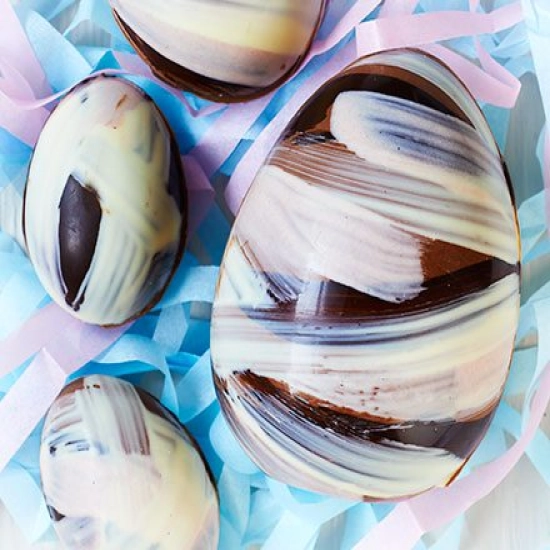Homemade Easter eggs
Ingredients
- Step 1 200g good-quality milk chocolate , about 36% cocoa solids
- Step 2 200g good-quality white chocolate
- Step 3 pink food colouring gel (optional)
- Step 4 100g plain chocolate , 70% cocoa solids (optional)
- Step 5 plastic Easter egg mould (made of two halves), either smooth or crackled (see tip)
- Step 6 wide artist's brush or clean pastry brush
- Step 7 kitchen thermometer that can read low temperatures
- Step 8 cotton or plastic gloves (from chemists)
- Step 9 a box , plus shredded paper or tissue to protect the egg (see tip)

Calories: 674
Carbohydrate: 64 g
Protein: 10 g
Fat: 42 g
Cook time: 55 minutes
Prep time: 45 minutes
Total time: 100 minutes
Servings: 11421048
TAGS
Afternoon tea
Dessert
Snack
Treat
British
30-60 minute
800 kcal or less
Easter present
Edible gift
Family friendly
Homemade Easter egg
How to temper chocolate
Jane Hornby
Milk chocolate
Spring
White chocolate
Directions
- Step 1 Wash each half of your Easter egg mould with hot soapy water and a soft sponge, then dry carefully. Using a ball of cotton wool, buff the inside of the mould. The better the shine on the mould, the better the finish on the chocolate.
- Step 2 Melt then temper the white chocolate for the brush strokes (see tip).
- Step 3 Colour half the melted white chocolate with a little of the gel if you want, then brush graphic stripes of chocolate onto the moulds. Let each colour set before you add the next (setting is really speedy if you've achieved good temper). Go over some stripes twice, to make the colours pop out. Repeat the melting and tempering process with the dark chocolate, if you like.
- Step 4 Line a baking sheet with parchment. Melt and temper the milk chocolate. Half-fill one mould with the chocolate, then tip it this way and that to completely cover the mould.
- Step 5 Pour the excess back into the chocolate bowl, and scrape a palette knife across the mould to clean it up. Repeat with the other half of the egg. Set the moulds, flat-side down, on the lined sheet. Transfer to the fridge and leave to set for about 10 mins.
- Step 6 When the chocolate is solid, flex the moulds to gently release. Take your time - you will see the air slowly creepy its way between the plastic and the shiny, hard chocolate. Heat oven to 180C/160C fan/gas 4.
- Step 7 Heat a baking sheet in the oven until warm. Put the gloves on (prevents fingerprints) and pick up one side of the egg. Any messy edges can be melted flat by holding them against the tray. Next, carefully rub the flat edge of the egg on the tray to melt it a little.
- Step 8 Repeat with the second side. If you're struggling to pick up the egg from the tray, use your palette knife to help.
- Step 9 Hold the melted edges of the egg together for a few moments until they stick. Wipe away any excess, then leave the egg to set in the fridge for a few mins. The egg is now ready to give or wrap up for Easter. Store in a cool place away from fluctuating temperatures.
